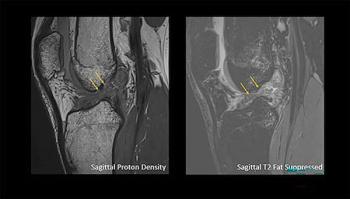
Imaging services provider TME spins off sister firm to build center networks
HHNI targets payors anxious about gatekeeper role A new radiologymanaged service organization (MSO) was created earlier this yearto network individual imaging centers in a capitated service programfor managed-care insurance payors. The concept
HHNI targets payors anxious about gatekeeper role
A new radiologymanaged service organization (MSO) was created earlier this yearto network individual imaging centers in a capitated service programfor managed-care insurance payors. The concept behind HealthHelpNetworks (HHNI) differs from that of previously established MSOs,such as Future Diagnostics and California Managed Imaging (SCAN12/29/93), according to HHNI Holdings chair and CEO Cherrill Farnsworth.
Rather than networking independent centers and then approachingmanaged health-care payors, HHNI approaches the payors first andoffers to subcontract, or carve out, responsibility for a packageof imaging services, she said.
Farnsworth is also chair of TME, a Houston multicenter imagingservices firm, which spun off HHNI Holdings into a separate sistercompany two months ago. TME shareholders were provided with stockin the new company and a different venture capital backer wassolicited for financial support, Farnsworth said.
HHNI's first target market is Florida. A survey of the state'sapproximately 260 imaging centers has been completed. One payorhas been contracted with, four are in the final stages of negotiationsand others are in process, she told SCAN.
Over 40 Florida centers -- more than half of HHNI's goal of75 -- have been accredited and signed by the network. Qualifyingcenters need not buy stock nor pay any fees to join the network.HHNI Holdings in Houston is now searching for a CEO for HHNI Florida,which will be based in Tampa. The network should begin functioningfor contracted payors by October, Farnsworth said.
Providing service packages to insurance payors under contracthas been successfully applied for years in fields outside radiology,she said. However, impending health-care reform and the ongoingtrend to managed care has created new incentives for insurancecompanies qua gatekeepers to farm out radiology services.
"We designed this (HHNI) to meet the payors' needs andwhat they see as their potential liability in requiring a patientto go to a certain center," she said.
Only imaging centers that meet HHNI's accreditation standardsare admitted to the MSO network. In accrediting centers, HHNIlooks at such factors as employment of board-certified radiologistsand licensed technologists, use of upgraded scanners and properinsurance coverage, Farnsworth said.
Leveraging know-how. TME's imaging management know-how andestablished radiology contacts are proving helpful in the effortto set up the MSO. HHNI is in the process of forming a panel ofexperts comprising luminary radiologists in all subspecialties.Once network operations begin, this panel will provide image qualityassessment and second opinions, she said.
Another HHNI physician group, dubbed the total quality managementcommittee, will provide peer reviews of center procedures sixtimes per quarter, Farnsworth said.
While TME provides services to HHNI, an independent networkorganization was required for both business credibility and antitrustregulatory reasons, she said. TME centers participate in HHNInetworks, but are not guaranteed a slot. HHNI itself does nothold equity interest in its network centers.
"There is a certain conflict of interest between owningcenters and managing someone else's radiology expenses,"Farnsworth said.
HHNI will take responsibility for quality assurance, cost controland management information reporting. Payors will be able to dealwith a unified organization and consistent reporting rather thansorting out individual center practices in what has traditionallybeen a cottage industry, she said.
The MSO is currently analyzing past radiology expenses forits contracted payors and potential clients. Most payors are notaware of their past radiology costs, she said.
"Our goal is to freeze (radiology expenses) at what theypaid last year and over time get to full capitation," Farnsworthsaid. "It will be shared-risk capitation in the first twoyears and then full capitation after that."
Under the shared-risk capitation concept, the payor may haveto provide fees for service if utilization per patient exceedsanticipated levels. On the other hand, the payor could receivea rebate if utilization is less than expected, she said.
Two Florida TME centers have been brought into the MSO. Butone TME center, which is MRI-only, will not be accepted untilit expands into full multimodality service, she said. TME willalso be contracted to build centers when coverage gaps exist.
Payors expect that clients should not have to drive more than20 minutes for an imaging procedure, Farnsworth said. Despitethe high density of imaging centers in Florida, there are someinstances when coverage must be filled in. In some cases, centersthat do not meet equipment standards may be admitted to the networkon a temporary basis to fill a gap, contingent upon their upgradingobsolete equipment.
As with TME, HHNI is developing group purchasing agreementswith scanner vendors and other suppliers. A scanner-purchasingrelationship has been arranged with Siemens, and HHNI is undernegotiation with GE and Picker, she said. When member centersneed to upgrade, they can do so through this discounted supplyarrangement.
Bulk purchases of contrast, film, insurance and other suppliesshould help HHNI reduce costs at member centers by about 20% inthe first year of operation, Farnsworth said. Centers will alsoavoid having to hire their own managers to interface with payors,or law firms to negotiate contracts.
Once HHNI Florida is functioning with management in place andseveral payor contracts in hand, HHNI Holdings will then moveon to the next state or region to set up new MSO networks, shesaid.
Newsletter
Stay at the forefront of radiology with the Diagnostic Imaging newsletter, delivering the latest news, clinical insights, and imaging advancements for today’s radiologists.




























